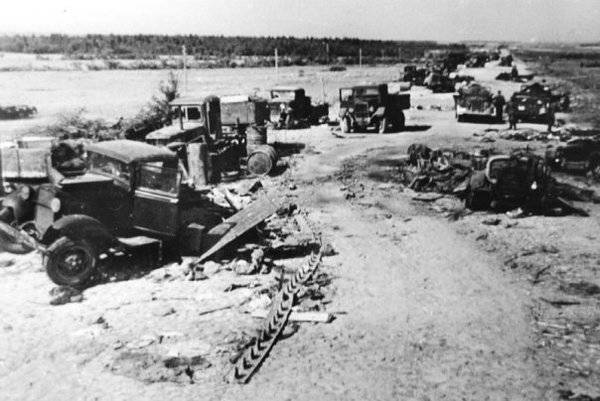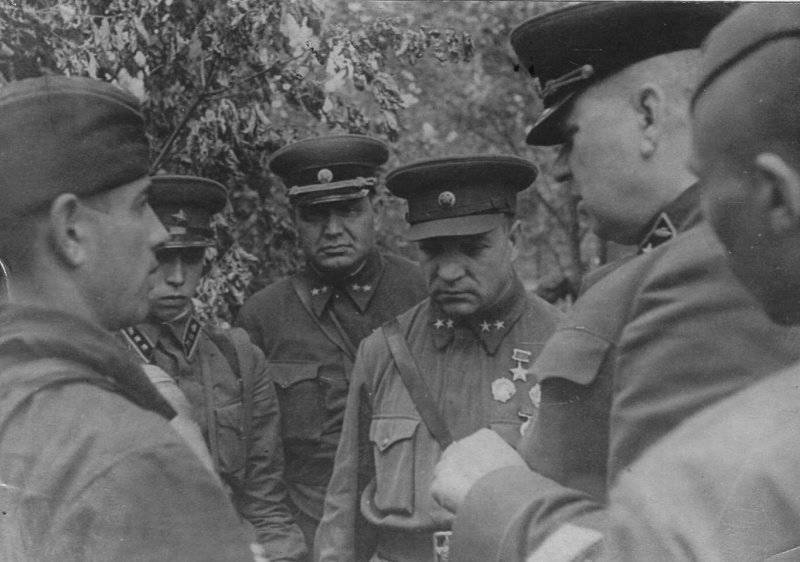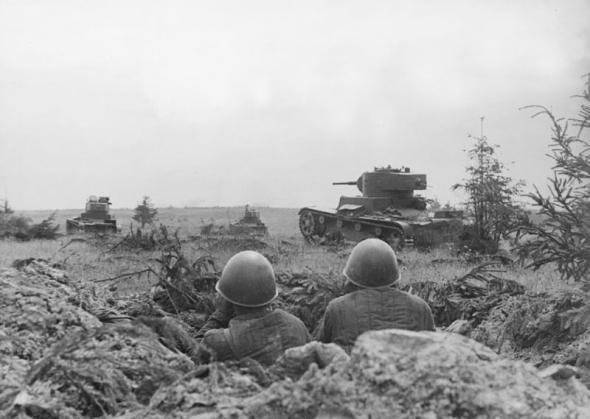1941 year. Defense of Borisov
The situation for 30 June 1941: On the 5 day of the war, the Germans captured Minsk, surrounding the main forces of the Western Front in the triangle Grodno-Brest-Minsk. The huge mass of Soviet troops had not yet been destroyed, but the troops were not trained to operate in such conditions. Before the war, according to the curriculum, actions in the offensive, attacks, marches were practiced; working out the defense, and even more, actions in the environment could well have become the basis for repression against the developers of such plans. Soviet propaganda vigorously introduced hats and slogans like “We will fight on foreign territory with little blood” to the masses. Although as early as the beginning of the 30-ies, there was a well-established system of training military leaders in environmental conditions in the Red Army, and in Ukraine and Belarus stocks were stored in caches weapons, ammunition and food for supplying troops in conditions of a deep penetration of the enemy. All these caches were destroyed by the NKVD, and many trained commanders of the Red Army and the personnel of the Red Army Intelligence Directorate, who specialized in sabotage and partisan actions, were shot in 1937. Therefore, the surrounded troops in the amount of about 250 thousand personnel quickly ceased resistance. Only a small part managed to break through to the east to their own, most were taken prisoner, many military personnel settled in the surrounding villages. By the end of June, the Western Front had only a few divisions at its disposal, which had suffered significant losses, while in Minsk two German tank groups - 2nd Guderian and 3rd Gotha. The 47th Panzer Corps of Guderian's group was supposed to advance as quickly as possible along the Brest-Moscow highway to Borisov, Orsha, Smolensk, in order to prevent the Soviet troops from organizing a solid defense.
From the memoirs of the famous Soviet writer and poet Konstantin Simonov:

Women, children, old people, girls with small knots, girls, young women, mostly Jewish, judging by clothes from Western Belorussia, in the miserable, turned into dusty rags of foreign coats with high shoulders, went from west to east along the road. It was a strange sight — these coats, knots in their hands, fashionable hairstyles on their sides. And from east to west along the road were civil guys. They went to their recruiting centers, to the place of gathering the units, mobilized, who did not want to be late, did not want to be considered deserters, and at the same time did not really know anything, did not understand where they were going. They were led forward by a sense of duty, complete uncertainty and disbelief that the Germans could be here, so close. It was one of the tragedies of those days. These people were shot from the air by the Germans, and they were suddenly captured for themselves ... ”
There was actually no one to defend the city of Borisov, located in 80 km east of Minsk, only a tank technical school (TTU) was stationed in it, where students studied around 500. From Moscow region, the 1-I Moscow Motorized Rifle Division was moving to Borisov — a fairly strong military unit that had more than 200 BT-7 tanks and several T-34, but would she have time? For the organization of defense along the Dnieper at the turn of Vitebsk-Orsha-Mogilev-Gomel there was a catastrophic lack of time, and it was vital to detain the enemy in Borisov, at the turn of the Berezina river. Meanwhile, the head of the Borisov TSU Corps Commissar Ivan Zakharovich Susaykov organized the defense of the city with the forces of his cadets: they dug trenches, communication lines, shooting cells. From the west, through a large concrete bridge to Borisov, one after another a group of Soviet fighters left without control, confused, did not understand - what was going on? Stepping heavily on dusty boots on the pavement, they walked onto the eastern bank of the Berezina, and the locals looked at them frowningly. Everything changed overnight. Suddenly he heard loud, clear commands emanating from a fit, self-confident colonel-tanker, who appeared on the shore accompanied by several commanders. Retreating soldiers unwittingly quickened their pace, corrected uniforms; here at the assembly point of them formed temporary military units - offices, platoons, companies. The collection and accounting of weapons, the supply of food and ammunition, and the entrenching tools were established. The colonel-tanker who organized this assembly point and the formation of the joint detachment of the retreating servicemen was Alexander Ilyich Lizyukov.

Alexander Lizyukov Alexander I. Born 26 March 1900, in the city of Gomel. Participated in the Civil War by the Red Army, commander of the artillery platoon, battery. In 1923 He graduated from the Higher Automobile Armored School in Petrograd, in 1927. Military Academy im.MVFrunze. From January 1933 of the year - the commander of the 3-th separate tank battalion, at 1934 he commanded a separate heavy tank regiment, and from March 1936, with the rank of colonel, became the 6-th separate heavy tank brigade. SM Kirov, which was armed with tanks T-28 and T-35. In 1935 was sent to France as part of the Soviet delegation of military observers on the maneuvers of the French army. 8 February 1938 was arrested by officers from the Special Section of the Leningrad Military District on suspicion of involvement in an anti-Soviet military conspiracy. During interrogations with torture, he was beaten up with evidence that Lizyukov allegedly "was going to commit a terrorist act against the Commissar Voroshilov and other leaders of the CPSU (B.) And the Soviet government by hitting a tank on the Mausoleum during one of the parades." 22 of the month was kept in the prison of the State Security Department of the NKVD of the Leningrad Region until December 3 of 1939, when the verdict of the military tribunal of the Leningrad military district was acquitted. 24 June 1941, Colonel A.I. Lizyukov was appointed Deputy Commander of the 17 Mechanized Corps and left Moscow for the front at the location of the corps headquarters ...
June 27-29, 1941 The soldiers of the consolidated detachment of Colonel Lizyukov strengthened on the western and eastern shores of the Berezina, carry out the engineering equipment of the positions. Tank cadets took up positions in the city itself. On the western coast of the Berezina, where the bridgehead of the Soviet troops was located, the first clashes with the Nazis began. German aviation daily bombing the city and the position of our troops in the area of the bridge.
30 June 1941. In the second half of the day, units of the 1 of the Moscow Motorized Rifle Division, Colonel Yakov Grigorievich Kreyzer, approach Borisov from the east. At the same time, the advance units of the German General Nering's 18 Panzer Division rush towards the city. The concrete bridge across the Berezina is mined by a group of sappers, the teams do not give explosives, as the situation is unclear, and groups of retreating Soviet troops periodically pass through the bridge. In particular, the approach of the retreating parts of the 20 and 44 corps of the Red Army was expected. On the morning of July 1, a massive Junkers raid took place, in which at least a hundred aircraft took part, at the position of the Soviet troops in the area of the bridge. Many German tanks appear on the west coast, they rush to the bridge, destroying the bridgehead fortifications already broken by the bombing. Despite the fierce resistance of the surviving defenders, the Germans manage to destroy their positions near the bridge, as well as the sappers, who were supposed to blow up the bridge, and gain a foothold on the east bank. The bridge went to the Germans in one piece, and it was very bad. However, the capture of strategically important bridges was quite common for the Germans at that time, for example, they also managed to seize bridges across Zapadnaya Dvina in Dvinsk in the actions of Army Group North, Berezina in Bobruisk to the south. In Borisov itself, fierce battles involving the combined detachment of Lizyukov, tank cadets, and units of the 1 motorized rifle division of J. Kreizer boiled. Ruben Ibarruri, the son of the famous Spanish communist Dolores Ibarruri, became one of the heroes of Borisov’s defense. He skillfully commanded a machine gun platoon, fought desperately, was seriously wounded. On July 1, the Germans dropped an airborne landing north of Borisov, which was destroyed in a fleeting battle by units of the 1 of the Moscow division.
To return the bridge or destroy it is very important. On July 2, Yakov Kreyzer, who concentrated a tank regiment from Borisov from his division, gives the order for a counterattack. High-speed BT-7 and well-armored T-34 hit the flank of the 18 TD, which operated in the area of Borisov.

A tank battle began in which hundreds of combat vehicles took part. From the letter of the German sergeant-major who was following in the column of the 18 TD:
The German units suffered heavy losses in the battles of 2 on July, they first met then with the Soviet “Thirty-four”, whose armor was difficult to break through. The commander of the German 2 Tank Group, Colonel General G. Guderian, wrote in his memoirs:
However, the Germans did not succeed in knocking down the Germans from the bridgehead seized on the eastern bank of the Berezina, mainly because of the actions of German aviation, which literally raged over the battlefield. July 1 and July 2 were fierce battles in Borisov and its environs, the Germans were forced to take house by house by storm, trench by trench. The tremendous numerical superiority of the German strike force could not but affect the outcome of these battles, and by the end of July 2, Borisov was abandoned by Soviet units. The surviving cadet tankers and fighters of the joint detachment of Colonel Lizyukov joined the division of J. Kreizer. Together with her, they went through a glorious battle journey from Borisov to Orsha, at every convenient turn to defend, arranging the Germans a cruel rattle. Let it be a retreat, but given the balance of power, these were truly heroic actions, and what is equally important is a vivid manifestation of the commanding talent of Soviet commanders: Alexander Lizyukov, Yakov Kreyzer, and others.
Results of Defense Borisov:
Skillful actions of the fighters and commanders of the Borisov Tank Technical School, the combined detachment of Colonel Lizyukov, the 1 of the Moscow division allowed for a few days to delay the advance of the Wehrmacht strike forces in the Moscow direction and made it possible to organize defense of the second strategic echelon of the Red Army along the Dnieper and Zapadnaya Dvina rivers the turn of the cities of Vitebsk-Orsha-Mogilev. The enemy suffered heavy losses. The commander of the Wehrmacht’s 18 Panzer Division, Major-General V. Nering, in his order on the results of the battles, wrote:
P.S:
After being wounded under Borisov, Corps Commissar Ivan Susaykov returned to political work and ended the war as Colonel General of Tank Forces, a member of the Military Council of the Second Ukrainian Front and Chairman of the Allied Control Commission in Romania.
On July 11, the commander of the 1 Moscow Motorized Rifle Division, Colonel Ya. G. Kreiser, was successfully promoted to the rank of Hero of the Soviet Union for his successful leadership of military units and personal courage and heroism, and on August 7 was appointed commander 25 th army of the Bryansk Front, which participated in the Battle of Smolensk and the defense of Moscow. In 3, Yakov Grigorievich was given the rank of army general.
Colonel A. I. Lizyukov for the defense of Borisov was presented to the Order of the Red Banner, but the submission was revised and he was awarded the title Hero of the Soviet Union. 23 July 1942. Major-General Lizyukov, commander of the 5 tank army, died in the course of a heavy battle in the Voronezh region under unclear circumstances, his exact burial place is doubtful, since the corpse of the general was severely disfigured and was not properly identified. However, in the memory of all patriots of the Fatherland, he will forever remain an example of loyalty to duty, a courageous man and a talented military leader.
Information sources:
1. The Great Patriotic War. 1941-1945. Encyclopedia "M., Soviet Encyclopedia, 1985.
2. Simonov K.M. "Different days of the war."
http://militera.lib.ru/db/simonov_km/1_01.html/index.html
3. Kreizer JG "In the battles between Berezina and the Dnieper."
http://www.rkka.ru/oper/1msd/main.htm
4. G. Guderian "Memories of a Soldier"
http://lib.ru/MEMUARY/GERM/guderian.txt
Information